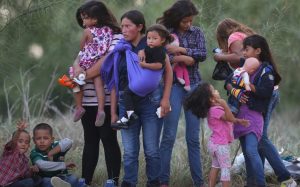By Mayra Beltran de Daetz

GUATEMALA CITY — Everything began Wednesday, May 26, 2010, about three in the afternoon. That’s when many in Guatemala City first felt a frightening tremor.
This tremor wasn’t the same which we customarily feel. Most of the time, it feels like a swing. This could be felt coming from the bottom of the Earth toward the surface. The movement we felt was impressive, but nobody imagined what would happen.
The rainy season had already begun in Guatemala and so the fact that it began to rain was not alarming. Yet, the sound was different.

Pacaya erupts with full force.
Many of us agreed that the rain that was falling sounded differently. That was when we realized this was no ordinary rain and everyone started shouting in alarm — it wasn’t water that was falling but rather rain mixed with sand and it was coming from where the tremor started — Volcano of Pacaya.
By Thursday May 27, what started with the tremor of the earth was followed by strong roars, and an eruption that produced big lava rivers — all this at 15:00 hours (3 p.m.). At 17:00 hours (5 p.m.), it began to rain huge rocks and fire that approximately reached about five hundred thousand meters of height causing the opening of lava cracks all around.
At 19:30 (7:30 p.m.), the sand rain mixture, covered towns like PalÃn, Sacatepequez, Amatitlán, Villa Nueva, San José Villa Nueva, Barcenas, Villa Canales and the city of Guatemala.
Many of us followed on television the tragedy and saw the impressive force of the volcano in the heat of its eruption. It was a scene never before seen, which brought feelings of admiration for the strength of this natural spectacle, but at the same time much fear. We became even more afraid when we thought about the people who lived so near the volcano, and who were being evacuated from their homes.
News reports said that there were more than 1,924 people evacuated, three disappeared and two died, among them a television news reporter. There were reports of continued explosions from the volcano every 5 to10 seconds, expelling columns of ash.

Volcanic ash coats Guatemalan neighborhood streets and yards.
The airport was closed and classes in the schools and universities were suspended, and many roofs could not withstand the weight of the sand. Heavy machinery was put into action to scoop up the volcanic sand and people started sweeping it from the front of their homes, placing it in plastic bags, as municipal authorities instructed us to do.
But that wasn’t the end of things. On Saturday, Guatemalans everywhere in the country had a very rainy day, because the first tropical storm of the season, called Agatha, entered national territory.
It affected 21 regions of Guatemala. The country’s infrastructure was damaged with floods and destruction. It also isolated thousands of towns while burying others. In the city, the storm damaged drainages, roads, and brought about the collapse in Zone 2 of the ground which created a hole with a diameter of 66 feet and approximately 100 feet deep, swallowing one factory but leaving others next to it in place. There were additional severe collapses in different places, damaging both houses and highways.
The latest news is that Pacaya Volcano has a new crater and lava is moving at 100 meters per hour threatening the destruction of a village that is on its doorstep. So far, the lava has covered extensive land area, not just searing away the earth but history and cultures as well.
This volcanic destruction has changed Guatemala. Among land sites in the country that have disappeared due to volcanic activity is a place called “the Georginas.” It was a thermal water source emanating from the Zunil Volcano that was discovered in 1902. The waters had curative powers because of its high mineral content. The Georginas was located in the region of Quetzaltenango and was one of the main tourist destinations in the area attracting thousands of foreign and national tourists every year.
Also, because of the volcano’s eruption there is an incredible amount of sand in the atmosphere. The sand is causing people to develop respiratory problems. For this reason, the Health Ministry has recommended the use of masks to filter the air we breathe.

People are evacuated in the aftermath of the volcano disaster.
Since both disasters have happened, many shelters for the victims have been established. Guatemalan society and the organizations in charge of these types of emergencies have created campaigns to provide the victims with food, clothes and medicine. These victims have not only lost their homes but also come from extreme poverty and are now completely without anything.
It is our hope that the government authorities do everything that is necessary to help the Guatemalans who need their help and count on the blessings of God to recover the beauty of our Guatemala.
Learn more about Mayra:
Mayra Etna Beltrán Molina de Daetz is a native-born Guatemalan who lives in Guatemala City with her husband and teenage son. After attending one of the most noted secretarial schools in the country, Mayra graduated with a secretarial certification — and the ability to speak and write English, as well as, know French.
Yet, she wanted more of a career and so she took architect and graphic design classes at a local university in Guatemala City. Unable to finish her university studies due to finances, Mayra became a stewardess and has over 100 hours in the air.
Yet, she always wanted to be involved with the media and so she returned to school and was able to get a degree in sales and marketing.
As a result, she has worked for a weekly magazine and a newspaper.
I have had opportunity to attend International congresses, in which I have known very important people at the more important international newspapers, which has been a very gratifying experience and has allowed me to have friendships outside of my country.




